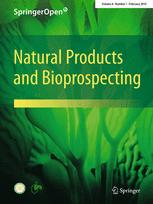|
|
Prenylated Coumarins from Heracleum stenopterum, Peucedanum praeruptorum, Clausena lansium, and Murraya paniculata
Collect
Xiang-Mei Li, Xian-Jun Jiang, Ku Yang, Li-Xia Wang, Shi-Zhen Wen, Fei Wang
Natural Products and Bioprospecting. 2016, 6 (5): 233-237.
DOI: 10.1007/s13659-016-0107-5
Four hitherto unknown prenylated coumarins, namely 6"-O-β-D-apiofuranosylapterin (1), 4'-O-isobutyroylpeguangxienin (2), 6-(3-methyl-2-oxobutyroyl)-7-methoxycoumarin (3), and 6-hydroxycoumurrayin (4), were isolated from the ethanol extract of Heracleum stenopterum, Peucedanum praeruptorum, Clausena lansium, and Murraya paniculata, respectively. Their chemical structures were established on the basis of extensive spectroscopic analysis. Compound 2 exhibited in vitro cytotoxic activity against five human cancer cell lines (HL-60, A-549, SMMC-7721, MCF-7, and SW-480) with IC50 values ranging from 15.9 to 23.2 μM.
References |
Related Articles |
Metrics
|
|
|
Lactam Triterpenoids from the Bark of Toona sinensis
Collect
Qian-Qian Meng, Xing-Rong Peng, Shuang-Yang Lu, Luo-Sheng Wan, Xia Wang, Jin-Run Dong, Rui Chu, Lin Zhou, Xiao-Nian Li, Ming-Hua Qiu
Natural Products and Bioprospecting. 2016, 6 (5): 239-245.
DOI: 10.1007/s13659-016-0108-4
Three new limonoid-type triterpenoids, namely toonasins A-C (1-3) with a rare lactam E ring, along with six known compounds (4-9) were isolated from the barks of Toona sinensis. The structures of new compounds were elucidated by interpretation of spectroscopic data, and the relative configuration of compound 1 was further characterized by X-ray crystallographic analyses. The isolated compounds were evaluated for their cytotoxic activities against five human tumor cell lines (HL-60, SMMC-7721, A-549, MCF-7 and SW480), and compounds 3 and 5 showed weak cytotoxicities.
References |
Related Articles |
Metrics
|
|
|
Clerodane Diterpenoids with Anti-hyperglycemic Activity from Tinospora crispa
Collect
Yuan Gao, Yan-Fen Niu, Fei Wang, Ping Hai, Fang Wang, Yin-Dong Fang, Wen-Yong Xiong, Ji-Kai Liu
Natural Products and Bioprospecting. 2016, 6 (5): 247-255.
DOI: 10.1007/s13659-016-0109-3
Four new clerodane diterpenoids, tinosporols A-C (2-4) and tinosporoside A (5), together with six known analogues were isolated from the vines of Tinospora crispa. Their structures were established by extensive spectroscopic analysis. The relative configuration at C-12 in the known diterpenoid borapetoside E (1), the major component of the plant, was firstly established with the aid of molecular model. Compound 1 significantly reduced serum glucose levels at dosedependent manners in alloxan-induced hyperglycemic mice and db/db type 2 diabetic mice.
References |
Related Articles |
Metrics
|
|
|
Furoquinoline Alkaloids and Methoxyflavones from the Stem Bark of Melicope madagascariensis (Baker) T. G. Hartley
Collect
Vincent E. Rasamison, Peggy J. Brodie, Emilio F. Merino, Maria B. Cassera, Michel A. Ratsimbason, Stephan Rakotonandrasana, Andriamalala Rakotondrafara, Elie Rafidinarivo, David G. I. Kingston, Harinantenaina L. Rakotondraibe
Natural Products and Bioprospecting. 2016, 6 (5): 261-265.
DOI: 10.1007/s13659-016-0106-6
Melicope madagascariensis (Rutaceae) is an endemic plant species of Madagascar that was first classified as a member of the genus Euodia J. R. & G. Forst (Rutaceae) under the scientific name Euodia madagascariensis Baker. Based on morphological characteristics, Thomas Gordon Hartley taxonomically revised E. madagascariensis Baker to be M. madagascariensis (Baker) T.G. Hartley. Chemotaxonomical studies have long been used to help the identification and confirmation of taxonomical classification of plant species and botanicals. Aiming to find more evidences to support the taxonomical revision performed on E. madagascariensis, we carried out phytochemical investigation of two samples of the plant. Fractionation of the ethanol extracts prepared from two stem bark samples of M. madagascariensis (Baker) T. G. Hartley led to the isolation of seven known furoquinoline alkaloids 1-7 and two known methoxyflavones 8 and 9. The presence of furoquinoline alkaloids and methoxyflavones in the title species is in agreement with its taxonomic transfer from Euodia to Melicope. Antiprotozoal evaluation of the isolated compounds showed that 6-methoxy-7-hydroxydictamnine (heliparvifoline, 3) showed weak antimalarial activity (IC50=35 μM) against the chloroquine-resistant strain Dd2 of Plasmodium falciparum. Skimmianine (4) displayed moderate cytotoxicity with IC50 value of 1.5 lM against HT- 29 colon cancer cell line whereas 3,5-dihydroxy-3',4',7-trimethoxyflavone (9) was weakly active in the same assay (IC50=13.9 μM).
References |
Related Articles |
Metrics
|
|

